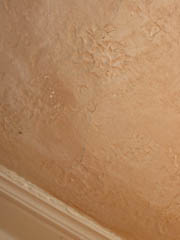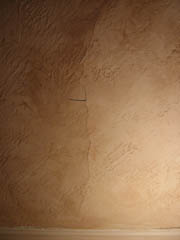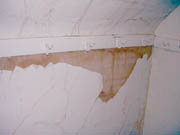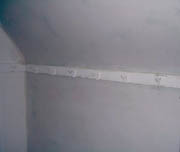great support and encouragement they have given me. And I especially thank the readers for the excellent questions, comments and encouragement that have been sent along the way. This has helped keep the momentum going and has shown clearly that the interest in the plastering trade is alive and well. I also thank the many companies that have sent products for me to test and review. This shows that creativity and imagination are key elements in ensuring that things will continue to improve and that a higher standard of quality is constantly being aimed for and achieved.

The first set of pictures were sent in by Justine, from Chicago, and I appreciate her writing and sending in the photos. Notice photos #1 and #2 show a faux-finished wall and the cracking that has occurred straight down the middle of the wall. In older homes, this type of cracking is very common. And it's also a common problem that occurs when the resurfacing of walls and ceilings is done improperly. I mention this because I have also just received a letter from a homeowner, complaining about a crew of plasterers who plastered her walls and now a crack very similar to the one shown in photo #1 is starting to appear.

IN OLDER HOMES
Settling cracks are very common in older homes but the ones in photos #1 and #2 have to do specifically with delaminating. What some people tend to overlook is the fact that a large amount of water is not necessary to cause such damage. A slow seepage from outside moisture can cause such damage. The reason is fairly simple to explain: First off, the crack does not go completely through all layers of the plaster on the wall. The finish coat is what is cracking. This is a fairly thin layer, the outer layer that the faux paint is applied over. It's a very dry plaster and when it gets wet or moist, the tendency is for it to separate away from the brown coat underneath. When tapped on, the plaster will sound rather hollow, though this is not always the case.
Sometimes, the separation is very small and therefore hard to detect. It's only after some of the finish coat is removed that it can be determined if delamination has occurred and how extensive it might be. This is often the challenge to the plasterer who may have to give an estimate solely from the outward appearance of the area. This is why I resort to the "best/worst-case scenario" estimating strategy-just to make sure I'm covered for any extensive repair work that might be necessary.

IMPROPER TECHNIQUES
However, there are also situations where older homes are worked on and resurfacing occurs, as I mentioned at the outset. The letter I received was from a homeowner who was not happy because the plaster began to show cracks about six months after the work was done. Upon further questioning, I was able to determine that there might be one of two explanations for the cracking problem.My first thought was that whoever did the work failed to use the proper bonding agent over the walls they were resurfacing. This is a critical point and one that is often overlooked or whose value is underestimated. A case in point: I had one individual e-mail me and explain that he had used Gardz-a damaged drywall sealer from the Zinsser Co. (This is a fine product for damaged drywall; to seal and harden the brown paper that might be exposed. And it's also good when used over aged drywall that is in need of a coat of plaster.)
However, it does not replace the need for a bonding agent over it. This was not done. And lo and behold, the plaster started delaminating after only a week or so. A disaster: yes. Avoidable: definitely. Acrylic- and latex-based bonder can solve many of such problems right from the start, if used properly. Of course, the first telltale sign of this type of delaminating is the hollow sound that makes the plaster that has been put over the old surface sound like a hollow egg when tapped on.
However, this was not the case in this lady's wall problem, so I had a second explanation, which was the failure to use mesh. This is also a problem that occurs quite a bit. It could be that the plasterer is in a hurry, wants to save money, or may simply overlook a crack that does not show up before the surface is plastered. I was called into one house that had this problem: The plasterer had done a good texturing job over older walls but failed to embed mesh into the basecoat to ensure that old cracks that were on the surface would not come back. Six months later, this is exactly what happened. I feel this is often the case with new plaster that is put over the old. I view fiberglass mesh as "insurance" against such cracks coming back and a good investment all the way around. It also gives added strength to the wall or ceiling.
Often, I find that failures in plastering projects are not due to a lack of troweling or mixing skills. It's often a matter of not following the proper techniques and steps that are essential in having a project turn out the right way.

WATER DAMAGE
Photo #3 is an example of another type of delaminating that occurs. This was in a closet and water had soaked this area for some time. The finish coat sustained extensive cracking. However, the basecoat was in good shape and the keys were still secure and in place in between the wood lath. The solution was to apply a bonding agent over the basecoat to give it added strength. Bonder was also applied to the areas around it where the finish coat would be applied and feathered in. This was allowed to dry overnight.Photo #4 illustrates that it was a simple application of finish coat plaster that was run on to complete this area. I embedded mesh over the basecoat where any hairline cracking might have been showing, which again ensures that cracks will not recur.
On another note: I have heard from some long-time plasterers and I invite anyone who's been in the plastering business for some time to get in touch. I am interested in including in future columns some of these stories. Plaster is an interesting topic but plasterers add the heartbeat and life to this subject.
I appreciate very much those of you who write and I value the friendships I've been able to make over the years.
The winner of this month's Walls & Ceilings/Plaster Man T-shirt is Robert Galikoff. Congratulations! To enter the contest, simply e-mail your name to robin@plasterzone.com or write to me in care of this magazine. Until next time, Plaster On!





